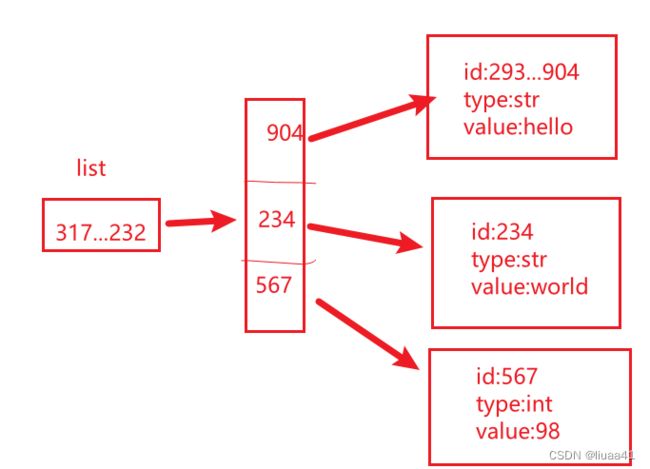3.列表
3.1 列表介绍

列表的特点:
- 列表元素按顺序有序排序
- 索引映射唯一个数据
- 列表可以存储重复数据
- 任意数据类型混存
- 根据需要动态分配和回收内存
list = ['hello','world',98]
print(id(list))
print(type(list))
print(id(list[0]))
print(type(list[0]))
print(list)

3.2 创建列表
list1 = ['hello','world',98]
list2 =list(['hello','world',98])
3.3 查询列表
- 获取列表中指定元素的索引index()
1.如查列表中存在N个相同元素。只返回相同元素中的第一个元素的索引
2.如果查询的元素在列表中不存在,则会抛出ValueError
3.还可以在指定的start和stop之间进行查找
- 获取列表中的单个元素
1.正向索引从0到N-1,举例: lst[0]
2.逆向索引从-N到-1,举例: lst[-N]
3.指定索引不存。抛出IndexError
list = ['hello','world','hello',98,90,0]
print(list.index('hello'))
print(list.index('hello',1,4))
print(list[2])
print(list[-3])
list = ['hello','world','hello',98,90,0]
list1 = list[1:6:1]
print(list1)
print(list[1:5:2])
print(list[1::2])
print(list[:5:2])
print(list[::2])
print(list[:5:])
print(list[5:0:-1])
print(list[::-1])

3.4 列表元素的查询操作
- 判断元素在列表中是否存在 in 或者 not in
- 列表的遍历
list = ['hello','world','hello',98,90,0]
print(id(list))
list.append(300)
print(list)
print(id(list))
3.5 列表元素的增加操作
list = ['hello','world','hello',98,90,0]
print(id(list))
list.append(300)
print(list)
print(id(list))
list = ['hello','world','hello',98,90,0]
list1 = ['my','test']
list.append(list1)
print(list)
list = ['hello','world','hello',98,90,0]
list.extend(list1)
print(list)
- insert() : 在列表的任意位置添加一个元素
list = ['hello','world','hello',98,90,0,300, 'my', 'test']
list.insert(1,90)
print(list)
list = ['hello','world','hello',98,90,0,300, 'my', 'test']
list[1:] = list1
print(list)
3.6 列表元素的删除操作
- remove() :一次删除一个元素;重复元素只删除第一个;元素不存在抛出ValueError
- pop() :删除一个指定索引位置上的元素;指定索引不存在抛出IndexError;不指定索引删除列表中最后一个元素
- 切片 :一次至少删除一个元素
- clear() :清空列表
- del() :删除列表
list = ['hello','world','hello',98,90,0]
list.remove(0)
print(list)
list.pop(1)
print(list)
list2 = list[1:3]
print(list2)
print(list)
list[1:3] = []
print(list)
list.clear()
print(list)
del list
print(list)
3.7 列表元素的修改操作
- 为指定索引的元素赋予一个新值
- 为指定的切片赋予一个新值
list = ['hello','world','hello',98,90,0]
list[2]='wow'
print(list)
list[1:3]=[1,2,3]
print(list)
3.8 列表元素的排序操作
- 调用sort()方法,列表中的元素按照从小到大的顺序排序,可以指定reverse=True,进行降序排序,列表id不变
- 调用内置函数sorted(),可以指定reverse =True,进行降序排序,列表id改变
list = [1,9,3,4,5,2,3,4]
list.sort()
print(list)
print(id(list))
list.sort(reverse=True)
print(list)
print(id(list))
list.sort(reverse=False)
print(list)
print(id(list))
list1 = sorted(list)
print(list)
print(id(list1))
list2 = sorted(list,reverse=True)
print(list2)
print(id(list2))
3.9 列表生成式(生成列表的公式
- 语法格式:[ i*i for i in range(1,10)]
- i:自定义变量;i*i:列表元素的表达式;range(1,10):可迭代对象
list = [i*2 for i in range(1,6)]
print(list)


